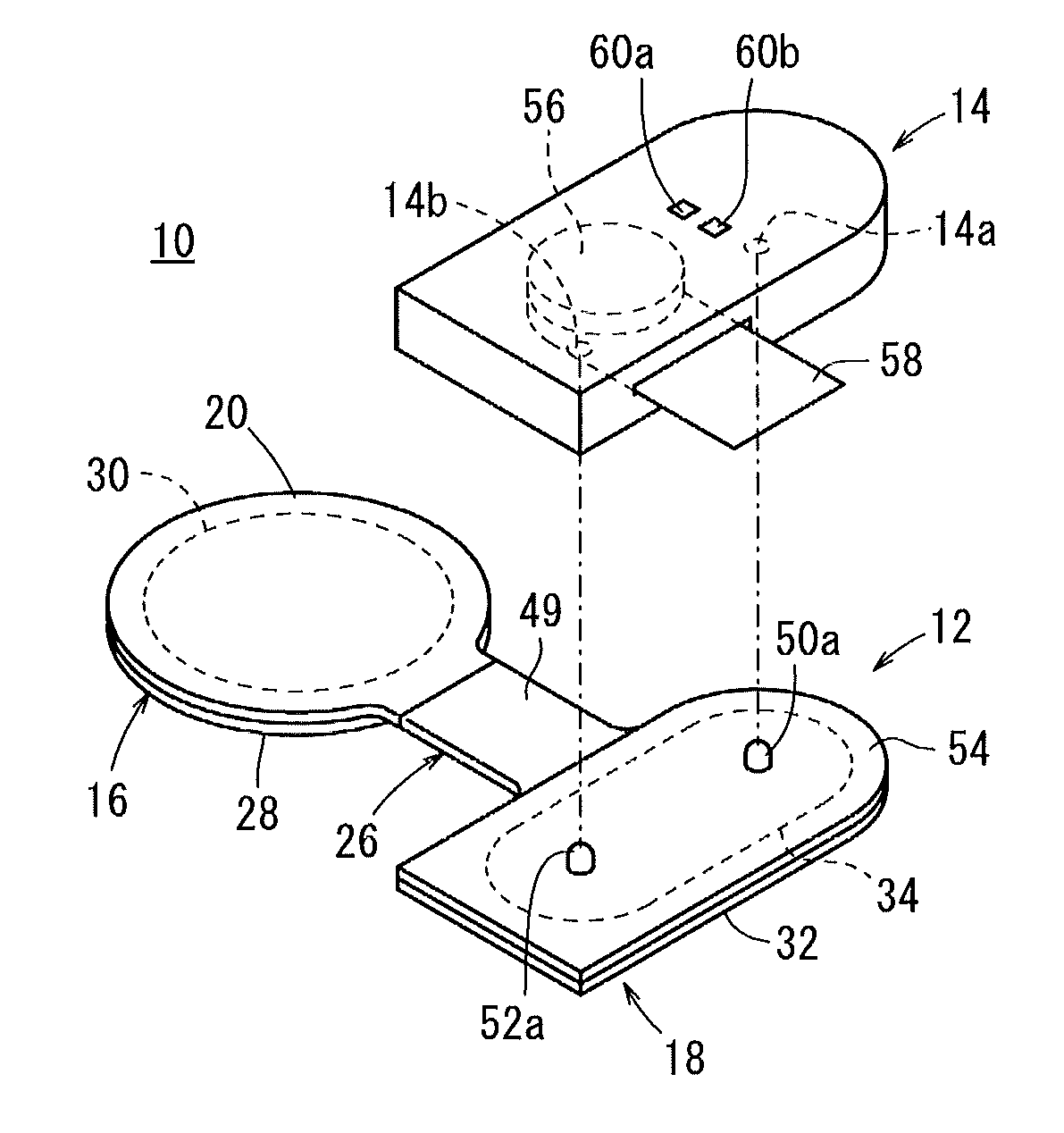Transdermal drug administration device
a technology of transdermal drug and administration device, which is applied in the field of transdermal drug administration device, can solve the problems of reducing the contact area between the patch and the skin, affecting the skin of patients, and allowing for continued energization, so as to achieve constant density of direct curren
- Summary
- Abstract
- Description
- Claims
- Application Information
AI Technical Summary
Benefits of technology
Problems solved by technology
Method used
Image
Examples
modification 9
[0118](Modification 9)
[0119]In Modifications 5 to 8 described above, the holes 210a and 210b are disposed on the insulating film 212 so as to be symmetric with respect to a straight line that is perpendicular to a straight line connecting the centers of the circular magnetic bodies 206a and 206b and passes through the midpoint M of the straight line connecting the centers. Therefore, if the energization device 204 is attached to the patch 202 in an orientation that is opposite to the predetermined orientation (by rotating the energization device 204 by 180 degrees), that is, if the energization device 204 is attached to the patch 202 such that the permanent magnet 216a attracts the magnetic body 206b, and the permanent magnet 216b attracts the magnetic body 206a, the spring probe 214a makes contact with the conductive plate 208b which is exposed through the hole 210b, and the spring probe 214b makes contact with the conductive plate 208a which is exposed through the hole 210a. There...
modification 10
[0124](Modification 10)
[0125]The pair of magnetic bodies 206a and 206b is used in Modifications 5 to 9 described above. However, as shown in FIG. 15, a pair of permanent magnets (second magnets) 220a and 220b may be used instead of the pair of magnetic bodies 206a and 206b. In this case, the pair of permanent magnets 216a and 216b of the energization device 204 is arranged such that magnetic poles of the permanent magnets 216a and 216b at a side that makes contact with the patch 202 are different from each other. Further, the permanent magnet 220a is provided instead of the magnetic body 206a, and the permanent magnet 220b is provided instead of the magnetic body 206b. When the energization device 204 is attached to the patch 202, the permanent magnets 220a and 220b are required to attract the permanent magnets 216a and 216b, respectively. Therefore, the pair of permanent magnets 220a and 220b is arranged in the patch 202 such that a magnetic pole of the permanent magnet 220a at a s...
modification 11
[0128](Modification 11)
[0129]In Modifications 5 to 10, as shown in FIGS. 10 and 11, the conductive plates 208a and 208b are respectively exposed through the holes 210a and 210b of the insulating film 212. However, the conductive plates 208a and 208b may be disposed over the holes 210a and 210b of the insulating film 212, thereby allowing the conductive plates 208a and 208b to make contact with the spring probes 214a and 214b, respectively.
[0130]Further, in the above embodiment, the insulating film 212 is disposed on the reference-side region 24 as shown in FIGS. 10 and 11. However, the insulating film 212 may not be provided. In this case, the diameter of each of the terminal bases 42a and 44a may be made smaller so as to be equal to the diameter of each of the holes 210a and 210b, and the terminal bases 42a and 44a may be arranged at the same positions as the respective holes 210a and 210b. Further, the insulating film 212 that covers only the connection lines 42b and 44b may be di...
PUM
 Login to View More
Login to View More Abstract
Description
Claims
Application Information
 Login to View More
Login to View More - R&D
- Intellectual Property
- Life Sciences
- Materials
- Tech Scout
- Unparalleled Data Quality
- Higher Quality Content
- 60% Fewer Hallucinations
Browse by: Latest US Patents, China's latest patents, Technical Efficacy Thesaurus, Application Domain, Technology Topic, Popular Technical Reports.
© 2025 PatSnap. All rights reserved.Legal|Privacy policy|Modern Slavery Act Transparency Statement|Sitemap|About US| Contact US: help@patsnap.com



